Overview
The intensified demand for IT network efficiency and lower operating costs has been driving the phenomenal growth of virtualization in the past decade, with no signs of slowing. At present, many corporations run more virtualized servers than physical servers.
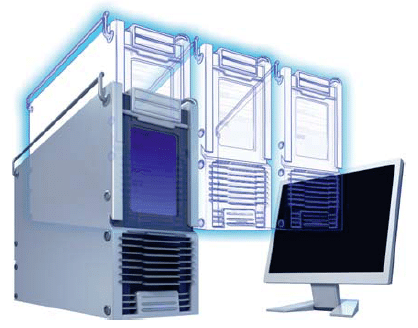
While virtualization provides opportunity for consolidation and better hardware utilization, it’s critically important to recognize and never exceed hardware capacities.
The importance of ensuring sufficient CPU and memory are well understood, with many processes and management tools available to help plan and properly provision VMs for these critical resources. I/O traffic, network and disk, are more complicated to account for in virtual environments as they tend to be more unpredictable.
In order to better accommodate disk I/O, most virtualization platforms will implement a Storage Area Network (SAN) which can offer greater data throughput, and a dynamic environment to address fluctuations in I/O demands.

While a storage infrastructure can be built out to meet expected demands, there are uncontrollable behaviors that will still impede performance.
File Fragmentation
As files are written to a general purpose local disk file systems, such as Windows NTFS, a natural byproduct is file fragmentation. File fragmentation is a state in which the data stream of a file is stored in non-contiguous clusters in the file system. Fragmentation occurs on logical volume, and by device drivers is translated to logical blocks, and eventually to physical sectors residing on a storage device. It can be demonstrated as pieces of a file located in a non-contiguous manner. The effect of this file fragmentation is increased I/O overhead, leading to slower system performance for the operating system.

In the case of virtual platforms, a guest operating systems is stored as a file (i.e. set of files) on the virtual platforms file system as a “virtual disk”. A virtual disk is essentially a container file, housing all the files that constitute the OS and user data of a VM. A virtual disk files can fragment just as any other file can resulting in what amounts to a “logically” fragmented virtual hard disk, which still has typical file fragmentation contained within it. The picture represented to the right would appear as “VirtualServer1.vmdk, 30GB in size, in 4 pieces”.
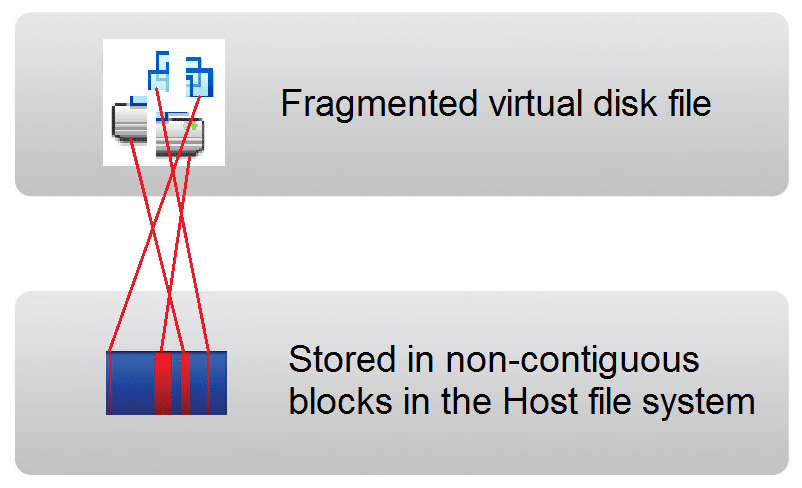
This situation equates to hierarchical fragmentation or more simply fragmentation-within-fragmentation. Given the relatively static nature and large size of virtual disks, and large allocation unit size of VMFS (typically 1MB), fragmentation of these files is unlikely to cause performance issues in most cases. The focus and solution to fragmentation should be directed at the guest operating system.
Fragmentation within a Windows VM will cause Windows to generate additional unnecessary I/O. This added I/O traffic can be discovered using Windows Performance Monitor, where it is one of the principal causes for Split I/O.

Fragmentation prevention and defragmentation technologies exist to eliminate unnecessary I/O overhead, and improve system performance. Fragmentation prevention solves fragmentation at the source, by actively causing files to be written contiguously via advanced files system drivers. Defragmentation is the action in which file fragments are re-aligned within the file system, into a single extent, so that only the minimal amount of disk I/Os are required to access the file, thereby increasing access speed.
Partition Alignment
Depending on your storage protocol and virtual disk type, misaligned partitions can cause additional unnecessary I/O[1]. In the example below in which the ESX and SAN volumes are not properly aligned, a Word file spanning four NTFS clusters causes additional unnecessary I/O in both VMFS and the SAN LUN.
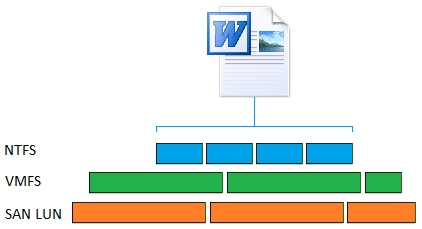
Similarities between Partition Alignment and Fragmentation
Much like misaligned partitions can cause additional I/O at multiple layers, so does fragmentation. While partitions can be properly aligned once and never require further corrective action, fragmentation will continue to occur, and needs to be regularly addressed.
In the example below, which assume proper partition alignment, a file in eight fragments in the guest OS, causes additional I/Os to be generated at the virtualization platform layer[2] and at the LUN.

Defragmentation in the guest operating system (of this file), eliminates excess I/O when accessing the file as Windows only generates one I/O. This reduction in I/O traffic translates to the host file system and SAN LUN, ensuring efficiencies at each layer.

Best Practices
Defragmentation of Windows file systems is a VMware recommended performance solution. The VMware Knowledge Base article 1004004[3] states “Defragmenting a disk is required to address problems encountered with an operating system as a result of file system fragmentation. Fragmentation problems result in slow operating system performance.” In order to validate the Vmware statement, tests were performed.
Test Environment
Configuration
Test Environment Configuration Host OS: ESX Server 4.1 with VMFS (1MB blocks)
Guest OS: Windows Server 2008r2 x64 (3GB RAM, 1 vCPU)
Benchmarking Software: Iometer (https://www.iometer.org/)
Fragmentation Program: FragmentFile.exe (used to fragment a specified file)
Defragmentation Software: V-locity® 3.0

Storage: 10GB test volume in a 40GB virtual disk. VMFS Datastore of 410GB. HP Smart Array P400 controller. RAID 5 (4x 136GB SCSI at 10K RPM) Stripe size of 64KB with a 64KB offset (properly aligned).
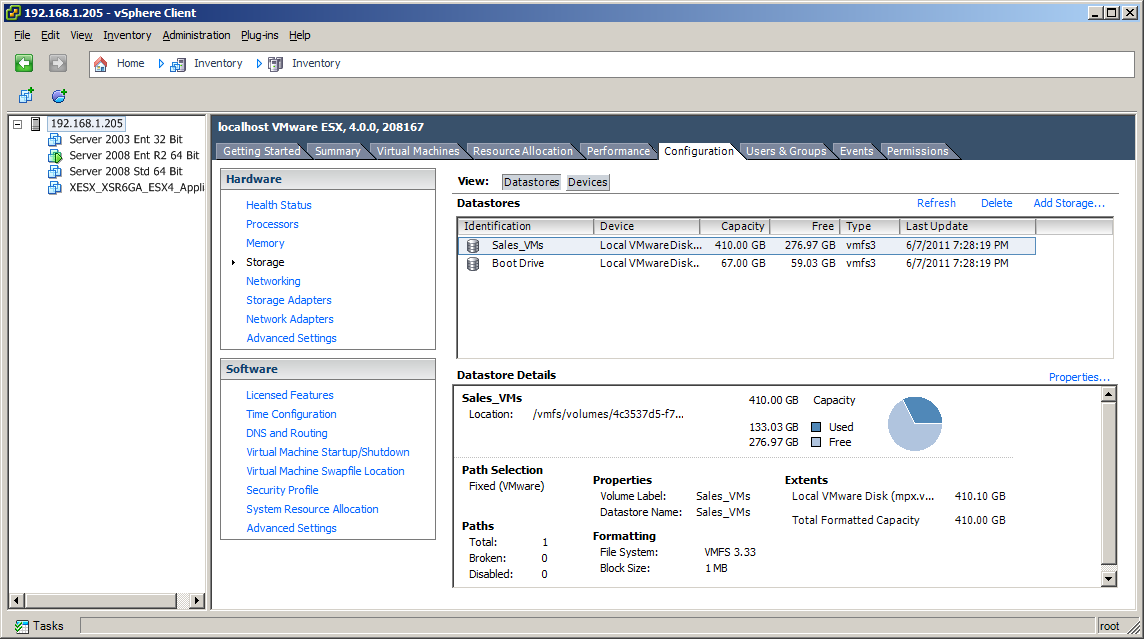
Load Generation
The industry standard benchmarking tool Iometer was used to generate I/O load for these experiments.
Iometer configuration options used as variables in these experiments:
- Transfer request sizes: 1KB, 4KB, 8KB, 16KB, 32KB, 64KB, 72KB, and 128KB
- Percent random or sequential distribution: for each transfer request size, 0 percent and 100 percent random accesses were selected
- Percent read or write distribution: for each transfer request size, 0 percent and 100 percent read accesses were selected
Iometer parameters that were held constant for all tests:
- Size of volume: 10GB
- Size of Iometer test file (iobw.tst): 8,131,204 KB (~7.75GB)
- Number of outstanding I/O operations: 16
- Runtime: 4 minutes
- Ramp-up time: 60 seconds
- Number of workers to spawn automatically: 1
The following is excerpted from a VMware white paper[4], and helps to explain why the Iometer parameters were used.
Servers typically run a mix of workloads consisting of different access patterns and I/O data sizes.
Within a workload there may be several data transfer sizes and more than one access pattern.There are a few applications in which access is either purely sequential or purely random. For example, database logs are written sequentially. Reading this data back during database recovery is done by means of a sequential read operation. Typically, online transaction processing (OLTP) database access is predominantly random in nature.
The size of the data transfer depends on the application and is often a range rather than a single value. For Microsoft Exchange, the I/O size is generally small (from 4KB to 16KB), Microsoft SQL Server database random read and write accesses are 8KB, Oracle accesses are typically 8KB, and Lotus Domino uses 4KB. On the Windows platform, the I/O transfer size of an application can be determined using Perfmon.
In summary, I/O characteristics of a workload are defined in terms of the ratio of read operations to write operations, the ratio of sequential accesses to random accesses, and the data transfer size. Often, a range of data transfer sizes may be specified instead of a single value.
Create Fragmentation
The FragmentFile.exe tool was used to fragment the Iometer test file (iobw.tst) into 568,572 fragments, a mid-range amount of fragmentation for a production server. The statistics collected from an analysis of the volume (shown below) were performed with V-locity.
Statistics
————————————————————————–
Volume Files
Volume size = 10,240 MB
Cluster size = 4 KB
Used space = 8,023 MB
Free space = 2,216 MB
Percent free space = 21 %
Free Space Fragmentation
Percent low performing free space: = 0 %
Total free space extents: = 3
Largest free space extent: = 911 MB
Average free space extent size: = 739 MB
Low-Performing files percentage
% of entire volume = 77 %
% of used space = 98 %
File fragmentation
Total files = 11
Average file size = 724 MB
Total fragmented files = 1
Total excess fragments = 568,572
Average fragments per file = 51,689.36
Files with performance loss = 1
Most Fragmented Files
————————————————————————–
Fragments File size Most fragmented files
568,572 7,941 MB \iobw.tst
Test Procedure
The primary objective was to characterize the performance of fragmented versus defragmented virtual machines for a range of data sizes across a variety of access patterns. The data sizes selected were 1KB, 4KB, 8KB, 16KB, 32KB, 64KB, 72KB, and 128KB. The access patterns were restricted to a combination of 100 percent read or write and 100 percent random or sequential. Each of these four workloads was tested for eight data sizes, for a total of 32 data points per workload.
In order to isolate the impact of fragmentation only the test VM was powered on and active for the duration of the tests.
For the initial run, Iometer created a non-fragmented file, and performance data was collected. Then FragmentFile.exe tool was used to fragment the Iometer test file, the VM rebooted, and the test procedure re-run. This resulted in data sets for both non-fragmented and fragmented scenarios. The results are graphed below.
Performance Results
As the graphs show, all workloads show an increase in throughput when the volume [file] is defragmented (i.e. not fragmented). It also becomes clear that as the I/O read/write size increases, the fragmentation-induced I/O latency increases dramatically. The greatest improvements of a contiguous file are found with file reads; both random and sequential.
Random Reads

Random Writes

Sequential Reads

Sequential Writes

Conclusion
Fragmentation demonstratively impedes performance of Windows guest operating systems. While the tests depicted were executed on a singular VM, the issue becomes exponentially worse in a multi-VM environment wherein each VM suffers from file fragmentation. As server virtualization establishes a symbiotic relationship, it is important to remember that generating disk I/O in one virtual machine affects I/O requests from other virtual systems. Therefore latencies in one VM will artificially inflate latency in co-located virtual machines (VMs that share a common platform).
Fragmentation artificially inflates the amount of disk I/O requests which, on a virtual machine platform, compounds the disk bottleneck even more so than on conventional systems.
Eliminating fragmentation in VMs, and the corresponding unnecessary disk I/O traffic, is vital to platform-wide performance and enhances the ability to host more VMs on a shared infrastructure.


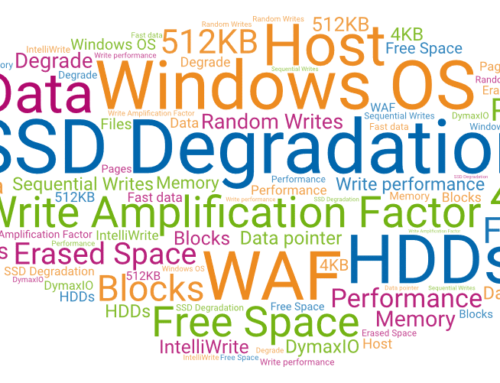


Great article. Adding to my favorites now!
There are good ideas in this article .. This site is one of my favorite
Hi Johann,
You are correct, that at the SAN "layer" the I/O overhead is not related to the I/O overhead in Windows – in some cases / with certain SANs. I’ll cover this in a new post in detail.
Your alignment graph is not true for NetApp und other SANs that re-order blocks for performeance.